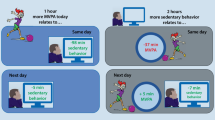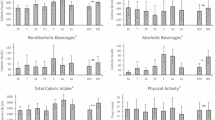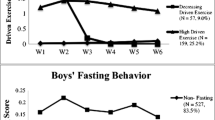Abstract
This experiment tested the effects of reinforcing obese children to be more active or less sedentary in their choice of active versus sedentary behaviors. On days 1 and 5, there were no contingencies for sedenlary or active behaviors. During days 2 through 4, children in the Activity group were reinforced for being more active, and they significantly increased their activity and decreased time spent on preferred sedentary activities. Children in the Sedenlary group were reinforced for not engaging in preferred sedentary behaviors, and they significantly decreased time spent on these sedentary behaviors, with time reallocated both to being more active and to substitution of lower preference sedentary behaviors. Children randomized to the Control group were reinforced for attendance and made choices among the alternatives as usual, allocating most of their time during all 5 days for their preferred sedentary behaviors. These laboratory results support the idea that activity can be increased by either reinforeing children for being more active or for reducing time spent in sedentary activities.
Similar content being viewed by others
References
Ainsworth, B. E., Haskell, W. L., Leon, A. S., Jacobs, D. R., Montoye, H. J., Sallis, J. R., & Paffenharger, R. S. (1993), Compendium of physical activities: Classification ofenergy costs of human physical activities.Medicine and Science in Sports and Exercise, 25, 71–80.
Astrand, P., & Rodahl, K. (1977).Textbook ofwark physiology: Physiological hasirs of exercise (2nd ed.). New York: McGraw-Hill.
Birch, L. L., Marlin, D. W., & Rotter, J. (1984), Ealing as the “means” activity in a contingency: Effects on young children’s food preference.Child Development.55, 431–439.
Catania, A. C. (1980). Freedom of choice: A hehavioral analysis, In G. H. Bower (Ed.),The psychology of learning and motivations (pp. 97–145). New York: Academic.
Dietz, W. H., & Gortmaker, S. L., (1985). Do we Fatten our children at the television set? Obesity and television viewing in children and adolescents.Pediatrics, 75, 807–812.
Dishman, R. K. (1990), Determinants of participation in physical activity. In C. Bouchard, R. J. Shepard, T. Stephens, J. R. Sutton, & B. D. McPherson (Eds.),Exerciser, fitness and health (pp. 75–101). Champaign, IL: Human Kinetics.
Epstein, L. H., Koeske, R. & Wing, R. R. (1984). Adherence to exercise in obese children.Journal of Cardiac: Rehabilitation, 4, 185–195.
Epstein, L. H., Smith, J. A., Vara, L. S., & Rodefer, J. S. (1991). Behavioral economic analysis of activity choice in obese children.Health Psychology.10, 311–316.
Epstein, L. H., Valoski, A. M., Vara, L. S., McCurley, J., Wisniewski, L., Kalarchian, M. A., Klein, K. R., & Shrager, L. R. (in press), Errects of decreasing sedentary behavior and increasing activity on weight changes in obese children.HealthPsychology.
Epstein, L. H., & Wing, R. R. (1987). Behavioral treatment of childhood obesity.Psychological Bulletin, 101, 331–342.
Epstein, L. H., Wing, R. R., Penner, B. C., & Kress, M. J. (1985). The effect of diet and controlled exercise on weight loss in obese children.Journal of Pediatrics.107, 358–361.
Epstein, L. H., Woodall, K., Goreczny, A. J., Wing, R. R., & Robertson, R. J. (1984). The modification of activity patterns and energy expenditure in obese young girls.Behavior Therapy.15, 101–108.
Falciglia, G. A., & Gussow, J. D. (1980). Television commercials and eating behavior ofohese and normal-weight women.Journal ofNutrition Education, 12, 196–199
Hamill, P. V. D., Drizd, T. A., Johnson, C. L., Reed, R. B., & Roche, A. F. (1994).NCHS growth curves for children birth-18 years. Washington. DC: U.S. Government Printing Office.
Hayashi, T., Fujino, M., Shindo, M., Hiroki, T., & Arakawa, K. (1987). Eehocardiographic and electrocardiographic measures in obese children after an exercise program.International Journal of Obesity.11, 465–472.
Hursch, S. R., & Bauman, R. A. (1987). The behavioral analysis of demand. In L. Green & J. H. Kagel (Eds.),Advances in behavioral economics (Vol. 1, pp. 117–165). Norwood, NJ. Ablex.
Jeffery, D. B., McLellarn, R. W., & Fox, D. T. (1982). The development of children’s eating habits: The role of television commercials.Health Education Quarterly.9, 78–93.
Lappalainen, R., & Epstein, L. H. (1990), A behavioral economic analysis of food choice m humans,Appetite.14, 81–93.
Martin, J. E., & Duhbert, P. M. (1982). Exercise applications and promotion in behavioral medicine: Current status and future directions.Journal of Consulting and Clinical Psychology, 50, 1004–1017.
Orlick, T. D., & Mosher, R. (1978). Extrinsic rewards and participant motivation in a sport related task.International Journal of Sport Psychology, 9, 27–39.
Rachlih, H. (1989).Judgement, decision, and choice: A cognitivelbehavioral synthesis. New York: Freeman.
Rodin, J. (1986). Aging and health: Effects of the sense of control.Science, 233, 1271–1276.
Sasaki, J., Shindo, M., Tanaka, H., Ando, M.. & Arakawa, K. (1987), A long-term aerobic exercise program decreases the obesity index and increases the high density lipoprotein cholesterol concentration in obese children.International Journal of Obesity, 1, 339–345.
Smith, J. A., & Epstein, L. H. (1991). Behavioral economic analysis of food choice in obese children.Appetite.17, 91–95.
Stunkard, A. J., & Pestka, J. (1962). The physical activity of obese girls.American Journal of Diseases of Children.103, 812–817.
Thompson, C. E., & Wankel, L. M. (1980). The effects of perceived activity choice upon frequency of exercise behavior.Journal of Applied Social Psychology.10, 436–443.
Tucker, L. A. (1986), The relationship of television viewing to physical fitness and obesity.Adolescence.21, 797–806.
Vara, L. S., & Epstein, L. H. (1993). Laboratory assessment of choice between exercise or sedentary behaviors.Research Quarterly for Exercise and Sport, 64, 356–360
Worsley, A., Coonan, W., Leitch, D., & Crawford, D. (1982). Slim and obese children’s perceptions of physical activities.International Journal of Obesity.8, 201–211.
Author information
Authors and Affiliations
Additional information
This research was supported in part by Grant HD 25997 awarded to Leonard H. Epstein.
Rights and permissions
About this article
Cite this article
Epstein, L.H., Saelens, B.E. & O’Brien, J.G. Effects of reinforcing increases in active behavior versus decreases in sedentary behavior for obese children. Int. J. Behav. Med. 2, 41–50 (1995). https://doi.org/10.1207/s15327558ijbm0201_4
Issue Date:
DOI: https://doi.org/10.1207/s15327558ijbm0201_4




